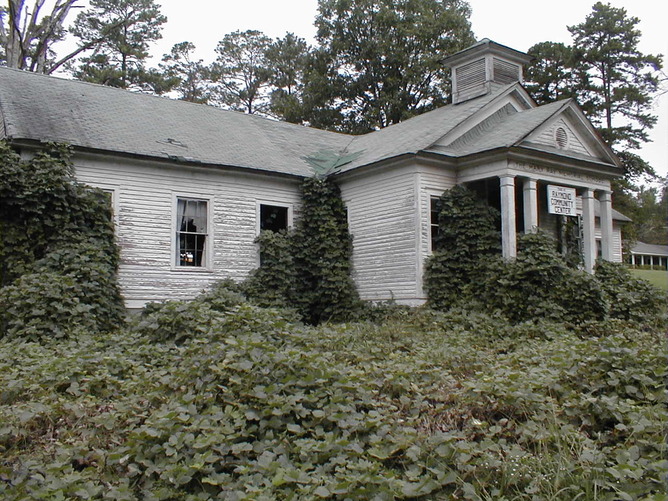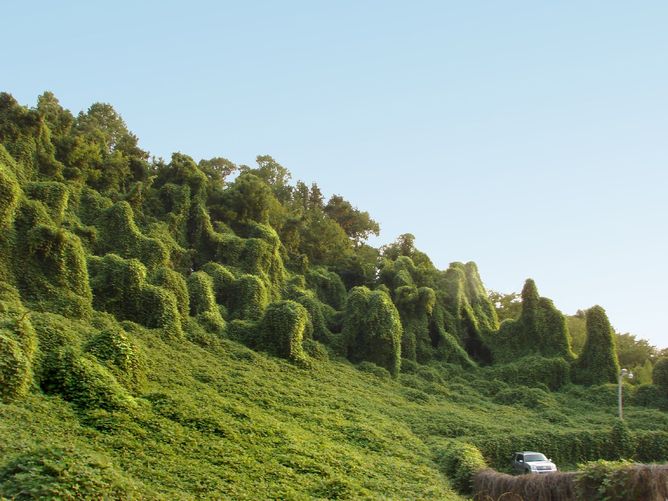
'Plant That Ate the South' Boosting Carbon Pollution

This article was originally published at The Conversation. The publication contributed the article to Live Science's Expert Voices: Op-Ed & Insights.
A plant called “the scourge of the South” has a new strike against it. Recent research shows that the impact of the invasive species in question, kudzu, is more troublesome than had been previously thought. When it takes over ecosystems, this invader causes soils to surrender their carbon and release it as greenhouse gas.
Alien invader
Kudzu is one of the most impressive invasive species in the world. Introduced to the US as a handful of plants in 1876, this invader now occupies over 3m hectares of land in the US, largely in the southeast of the country. It is estimated to be “consuming” land in the USA at a rate of 50,000 hectares per year to this day.
If anything could be said to grow like a weed, it is kudzu. It grows at an impressive rate of up to a metre every three days. The plant moves like a wave, smothering everything in its wake – trees, utility poles and even buildings.
It is a member of the legume family of plants – like beans – and grows in a vine-like manner, laying down roots whenever it comes into contact with the ground. Originally introduced as an ornamental plant and then for livestock feed and erosion control, it has since overrun entire ecosystems, destroying native long-needled pine forests, woodlots, and grasslands alike.

In addition to the damage it inflicts by overwhelming other plants, kudzu has indirect effects as well. Most notably, it carries the “kudzu bug”. This foul-smelling insect is also an invasive species. Unfortunately, the kudzu bugs' taste extends beyond its namesake plant, and includes other legumes, such as beans grown for human consumption. This means kudzu’s impact is not only native ecosystems, but agricultural productivity as well.
Kudzu’s direct and indirect cost to the US economy is estimated to be in excess of US$500m annually. That cost may be set to increase. Rising temperatures and lengthened growing seasons in the northernmost front of the kudzu’s range are creating a welcoming environment for further invasion. Where it was once restricted to south-eastern states, Kudzu is now found in more northerly states, including New Jersey and Ohio.
Sign up for the Live Science daily newsletter now
Get the world’s most fascinating discoveries delivered straight to your inbox.
New research suggests that kudzu’s negative impact may extend beyond that already documented. Its invasion may also be contributing to the rise in global greenhouse gases, by altering soil composition.
What lies beneath
Soil holds a phenomenal amount of carbon. In fact, there is more carbon stored in soil than in the atmosphere and in terrestrial plants, combined. Soil carbon comprises roots from plants, dead matter and waste from plants and animals, and a vast population of microbes. Together they are known as soil organic matter. Much of this comes from plants – mainly dead leaves – but also from dead roots, as well as stems, branches, and tree trunks that have fallen to the ground.
The carbon in the organic matter largely stays locked away in the soil, like an enormous reservoir. Over time, carbon is released as greenhouse gases – carbon dioxide and methane – when the matter is degraded by soil microbes. The extent to which carbon is determined by its susceptibility to microbial degradation.
The problem with kudzu is that it changes the rate at which carbon remains locked away in the soil. It changes the degradation rate of the organic matter.

In a paper published in the journal New Phytologist, plant ecologist Nishanth Tharayil and graduate student Mioko Tamura, of Clemson University, show that kudzu invasion results in an increase of carbon released from the soil organic matter into the atmosphere. Tharayil and Tamura investigated the impact of a kudzu invasion in native pine forests. They found that the invasion actually increased the amount of leaf material contributed to the soil, but, despite this, soil carbon decreased by nearly a third in those forests.
Tharayil and Tamura attribute the release of carbon from kudzu-invaded forests to the fact that kudzu adds material to the soil that is susceptible to degradation relative to that produced by pine. Simply put, kudzu leaves and stems are easy for microbes to degrade, pine needles and stems are not. This means that carbon is locked in with waste from pines; whereas, it gets released by kudzu.
When kudzu invades, its leaves, stems, and roots become the major plant contributors to the soil organic matter, replacing pines' contribution. This has a three-fold effect. First, over time, the hard-to-degrade pine matter decreases in abundance. Second, the easy-to-degrade kudzu matter actually encourages the degradation of the pine matter. That is, kudzu material “primes” the soil microbes to be more effective at degrading the plant material in the soil, including that previously contributed by pines. Finally, after invasion, the kudzu matter is simply more rapidly degraded itself. The net result of these three effects is that plant material is more rapidly degraded – it doesn’t persist like it did in the pine forests.
The south will rise again?
The impact of kudzu invasions on the release of former pine forests could be substantial. Tharayil has estimated that kudzu invasion might cause the release of 4.8 tonnes of carbon per year. This is the equivalent of the amount of carbon stored almost 5m hectares of forest, or the amount of carbon released by burning 2.3m tonnes of coal annually. That is approximately the same as the annual carbon footprint for a city of 1m in that part of the world.
The release of this amount of carbon into the atmosphere, as carbon dioxide, could itself contribute to global warming. This could create a snowball effect, as elevated temperature would enable kudzu to extend its range to more northern latitudes.
Not all news from Tharayil and Tamura is bad. They also looked at the impact of the invasion of another noxious weed, knotweed, on old fields. They found that knotweed, resulted in a net increase in carbon locked away in the soil. This is not to say that allowing knotweed to run rampant is the solution to kudzu’s carbon-releasing menace. Instead, the findings point to the fact that plant composition in different ecosystems could actually be managed to reinforce carbon retention in the soil, and prevent carbon release into the atmosphere.
In the meantime though, we are going to have to find a way to restrain the plant that ate the south, before it loads our skies with more carbon.
Next, read this: Why one hectare of rainforest grows more tree species than US and Canada combined
Malcolm Campbell receives funding from the Natural Sciences and Engineering Research Council of Canada, and from Genome Canada.
This article was originally published on The Conversation. Read the original article. Follow all of the Expert Voices issues and debates — and become part of the discussion — on Facebook, Twitter and Google +. The views expressed are those of the author and do not necessarily reflect the views of the publisher. This version of the article was originally published on Live Science.









